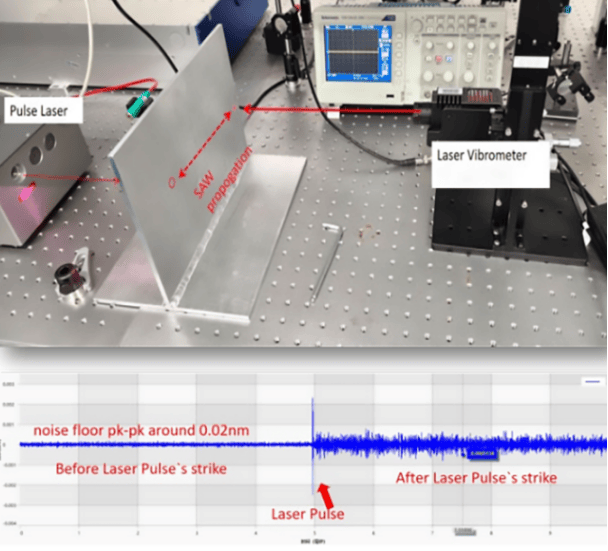Laser Ultrasonic Testing for Material Characterization
1. Application Overview
This case presents the implementation of laser ultrasonic testing combined with VibroMicro Laser Doppler Vibrometer for non-destructive material characterization of aluminum alloy plates. The methodology enables precise detection of internal defects and material property assessment through advanced vibration measurement techniques. validation and quality assurance.
2. Technical Principle
Laser ultrasonic testing integrates pulsed laser excitation with laser Doppler vibrometry to create a completely non-contact measurement system:
Excitation Phase: A high-energy pulsed laser generates ultrasonic waves through thermoelastic effect
Detection Phase: VibroMicro laser Doppler vibrometer detects surface vibrations on the opposite side
Synchronization: Precise triggering ensures accurate timing correlation between excitation and detection
3. System Configuration
VibroMicro Laser Doppler Vibrometer with nanometric resolution
High-energy Pulsed Laser System (Nd: YAG, 1064 nm wavelength)
Synchronization Electronics for precise trigger management
XYZ Positioning System for automated scanning
Data Acquisition Unit with high sampling rate (≥100 MS/s)
Advanced Signal Processing Software
4. Measurement Methodology
4.1 Sample Preparation
Aluminum alloy plate (600×600×5 mm)
Surface preparation to ensure optimal laser reflection
Reference markers for coordinate registration
4.2 Data Acquisition Protocol
Grid-based scanning with 2 mm spatial resolution
Multiple averages per measurement point (typically 16)
Environmental vibration isolation
Temperature stabilization at 23±1°C
5. Results and Analysis
5.1 Signal Characteristics
Typical pulse amplitude: 1.2 nm (half-peak value)
Pulse duration: 50 μs
Signal-to-noise ratio: >30 dB
Clear identification of longitudinal and shear wave components
5.2 Material Property Assessment
Wave velocity mapping revealed variations of ±2.5% across the plate
Attenuation coefficients showed correlation with material microstructure
Anisotropy detection in rolling direction
5.3 Defect Detection Capability
Successful identification of artificial defects (0.5-2 mm diameter)
Detection of laser welding imperfections
Mapping of material inhomogeneities
Characterization of thermal stress distribution
6. Technical Advantages Demonstrated
6.1 Measurement Performance
Non-contact operation eliminates couplant-related issues
High spatial resolution (sub-millimeter capability)
Superior sensitivity to weak vibration signals
Absolute calibration traceable to international standards
6.2 Operational Benefits
Rapid scanning capability (up to 100 points/hour)
Suitable for complex geometries and high-temperature applications
Minimal sample preparation requirements
Comprehensive data acquisition and analysis workflow
7. Quality Control Applications
The methodology has been successfully implemented for:
Weld quality assessment in automotive components
Detection of kissing bonds in aerospace structures
Thickness mapping of corrosion-prone areas
Process control in additive manufacturing
Material certification for nuclear industry applications
8. Comparative Analysis
Compared to conventional ultrasonic testing:
3x better resolution for near-surface defects
Elimination of transducer coupling variability
Enhanced capability for automated inspection
Superior performance on rough surfaces
9. Conclusion
The integration of VibroMicro Laser Doppler Vibrometer with laser ultrasonic testing provides a powerful solution for advanced material characterization. The system's high sensitivity, combined with completely non-contact operation, enables reliable detection of minute defects and detailed mapping of material properties. This case demonstrates the methodology's effectiveness for quality control in demanding industrial applications, particularly where conventional ultrasonic methods face limitations. The technical approach offers significant advantages for manufacturers requiring precise, reliable, and efficient non-destructive testing capabilities.

